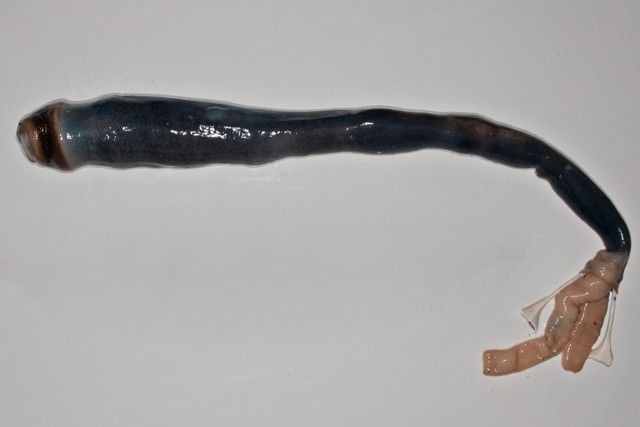WATCH: After centuries, scientists finally found this freaky 'unicorn of mollusks' in the Philippines
April 22, 2017 | 12:10pm

This undated handout photo made available by Marvin Altamia on April 19, 2017 shows the length of a giant shipworm, a species never before studied, after removal from its shell, at a laboratory in Manila. Extremely rare live specimens of a giant shipworm have been found for the first time in southern Philippine waters, with scientists hailing the soft black creature as a remarkable species. The discovery of the giant shipworm, a species never before studied, marked the first time scientists had live specimens at hand, according to a US science journal article published this week.
Marvin Altamia via AFP
MANILA, Philippines — Scientists were excited with the latest find they plucked under a lagoon in Sultan Kudarat—a creepy "worm" living in smelly toxic gas-emitting mud.
The giant shipworm, which has the scientific name Kuphus Polythalamia, has eluded scientists for centuries.
Scientists have known its large tusk-like shells measuring three to five feet since the 18th century. The creature living inside, however, has never been seen until now.
The scientists got a lead on its whereabouts after stumbling upon a documentary in the Philippines about the elongated mollusk.
Locals in Kalamansig, Sultan Kudarat in the southern Philippine island of Mindanao know it as tamilok, a local delicacy believed to be an aphrodisiac.
Medicinal chemist Margo Haygood, part of the team that studied it, said the find was a highlight of her career.
"The animal has a mythical status—it’s like a unicorn,” she added.
Despite its name, the giant shipworm is not a worm but a mollusk like squids and snails.
Shipworms are notorious for burrowing in wooden ships and eating its lumber. But unlike their smaller relatives, giant shipworms are nourished by carbon produced by bacteria that feed on the toxic and rotten egg-smelling hydrogen sulfide. The bacteria is found in its gills.
Without the need to digest food, the giant shipworm's digestive organs have shrunken.
Scientists were astonished by the symbiotic relationship of the bacteria and the giant shipworm, saying that it could help deepen understanding of infections.
Studies are also being conducted on the bacteria for possible pharmaceutical use.
Find out more about this fascinating creature here:
— Text by Mikas Matsuzawa; Video by Efigenio Toledo IV
BrandSpace Articles
<
>
Philstar
x
- Latest
- Trending
Trending
Latest
Trending
Latest
Recommended


















 Exclusive
Exclusive








